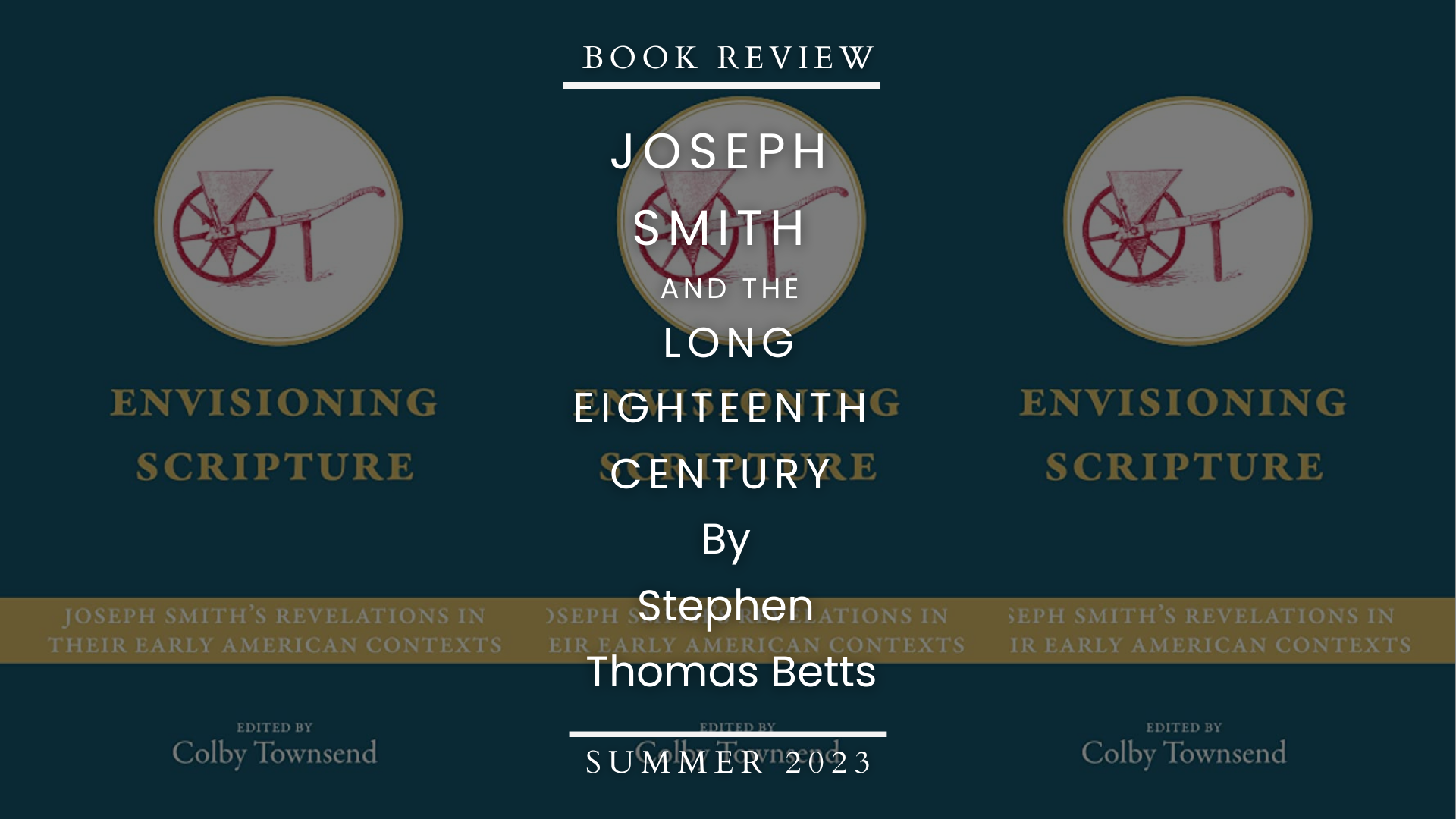Articles/Essays – Volume 56, No. 2
Joseph Smith and the Long Eighteenth Century | Colby Townsend, ed., Envisioning Scripture: Joseph Smith’s Revelations in Their EarlyAmerican Contexts
The ten essays in this volume were brought together to facilitate engagement between scholars of “early Mormonism and early American religious and literary history” (ix). With a designedly inter- or transdisciplinary ambition, Envisioning Scripture assembles the likes of narrative analysis, print culture studies, and translation studies—to name only three—to establish an early American context for Joseph Smith’s scriptural productions. Unique among similarly disposed volumes such as Americanist Approaches to the Book of Mormon, Envisioning Scripture considers the “long eighteenth century, roughly spanning 1660 to 1830” (vii) as Smith’s cultural environment. In Mormon studies, scholarship on the long eighteenth century has historically centered, among other things, the myths of scattered Israel and the metaphysics of Western magic, but the comparative and thematic work in the present volume highlights less common approaches to this period vis-à-vis early Mormonism. These include American revolutionary culture, the formation of the public sphere, prophetic culture in the late eighteenth century, and the radical changes that such factors produced in the activities of interpreting and producing scripture and religious authority.
While not formally organized into thematic sections, the essays in Envisioning Scripture fall into two broad categories: seven essays that directly treat Mormonism, and three others that do not. In the former group, William Davis challenges traditional accounts that accepted Joseph Smith’s family’s claim that he had little formal education, arguing instead that Smith had at least “seven full school years” (64) and ample access to print media. Unpacking the implications of this analysis is part of the central labor of Davis’s 2020 monograph, Visions in a Seer Stone: Joseph Smith and the Making of the Book of Mormon (UNC Press). Elizabeth Fenton reads the Book of Mormon as a performative critique of canonicity itself in which “history and . . . history-making” are shown to be fissured with “erasure, failure, and loss” (75). The Book of Mormon as a new sacred (Anglo-)American history is a tale of “conting[ency]” in which, far from a definitive account of history, Fenton finds it “endlessly open to proliferation” (96). Kathleen Flake argues for an understanding of Smith’s “translation” as an appropriation of the narrative time in the Bible that “gave his believing readers a sense of what was experientially real, not merely philosophically true” (154). This embodied experience of Smith’s “myth-making imagination” entailed “the power to shape reality, not merely describe it” (155). Paul Gutjahr contends that “the Book of Mormon’s initial material design, narrative format, linguistic peculiarities, and marked preoccupation with American history” (159) are features that rendered the book “credib[le]” and “trustworthy” in the idiom of “early nineteenth-century American print culture” (176). Roberto A. Valdeón introduces the translation studies terms of “pseudotranslation” (179), “intralingual translation,” and “intersemiotic translation” to describe functionalist arguments familiar to Mormon studies about the authenticity of Smith’s translations (186). Laura Thiemann Scales conducts a comparative assessment of the ways in which Black revolutionary Nat Turner and Joseph Smith both “strategically revise the formal grammar of prophecy” (236), using a narrative “apparatus of multiple voices to produce divine authorship” (231). This literary performance of vocal multiplicity reveals a “prophetic personhood [that] provides an alternative to liberal individuality and interrogates the very value of individuality” (227). Jared Hickman reads “the Book of Mormon’s formal logic and not just its eschatological content” (277) as a self-deconstructing “metacritique of [the book’s own] theological racism” (279) culminating in what he calls the “apocalypse” in/of “the text” (287)—namely, a conspicuous undermining of literalist biblical hermeneutics in antebellum America via the apocalyptic unveiling of the text’s own “human conditions of scripture writing and scripture reading” (288), a “metatextual navel-gazing [that] profoundly destabilizes its self-canonizing narrative, opening it to ethical critique from without and within” vis-à-vis theological racism (293).
The remaining three essays consider contextual features of early American print culture and its relationship to religious authority and religious experience. Catherine A. Brekus writes about the increase in women’s religious writings during the mid-eighteenth century, which she keys to the discursive opening in a male-dominated print culture introduced by evangelicalism’s embrace of the evidentiary value of religious experience during the First Great Awakening. Seth Perry addresses how Alexander Campbell’s complex view of making transparent the meaning of the New Testament through translation and editing resists scholarship that has “miss[ed] the historicizing impulse at the core of primitivist thought: [namely,] the biblical texts had to both have a history and transcend it” (120). Susan Juster discusses the gendered expectations about millenarian prophets in revolutionary America, most especially that women’s oral- and mystical-based authority were viewed as a challenge to the emergent male-dominated republican public sphere of rational, deliberative, democratic communication. Ironically, she notes, “it was republican prophets who found themselves pushed to the margins of Anglo-American political culture after 1815 rather than the mystagogues they scorned” (265). Case in point? Joseph Smith (267).
Envisioning Scripture is a useful introduction to the early American context of Joseph Smith’s revelations. While Mormon studies specialists will find much familiar territory covered, the mixture of classic and lesser-known essays will reward multiple readings. Although the volume would have benefited from an index and more robust editorial summary in the introduction, Envisioning Scripture is highly recommended for anyone interested in early Mormonism.
Colby Townsend, ed. Envisioning Scripture: Joseph Smith’s Revelations in Their Early American Contexts. Salt Lake City: Signature Books, 2022. 316 pp. Paper: $18.95. ISBN: 978-1-56085-447-0.
Note: The Dialogue Foundation provides the web format of this article as a courtesy. There may be unintentional differences from the printed version. For citational and bibliographical purposes, please use the printed version or the PDFs provided online and on JSTOR.


 Back to full Issue
Back to full Issue

